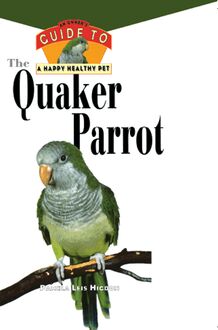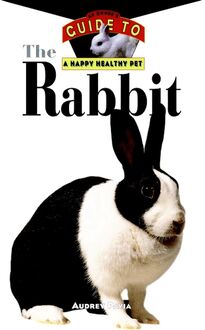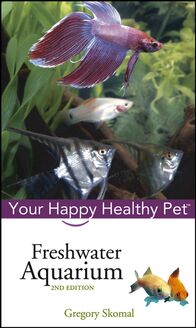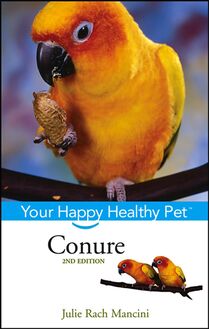The Cichlid , livre ebook
78
pages
English
Ebooks
2008
Vous pourrez modifier la taille du texte de cet ouvrage
Obtenez un accès à la bibliothèque pour le consulter en ligne En savoir plus
Découvre YouScribe en t'inscrivant gratuitement
Découvre YouScribe en t'inscrivant gratuitement
78
pages
English
Ebooks
2008
Vous pourrez modifier la taille du texte de cet ouvrage
Obtenez un accès à la bibliothèque pour le consulter en ligne En savoir plus
Publié par
Date de parution
05 mai 2008
Nombre de lectures
2
EAN13
9780470370957
Langue
English
Poids de l'ouvrage
2 Mo
PART ONE: Welcome to the World of the Cichlid.
1. What Is a Cichlid?
2. Cichlid Behavior in the Aquarium.
PART TWO: Cichlids in the Home.
3. Setting Up the Cichlid Aquarium.
4. Aquarium Care and Maintenance.
5. Selecting Cichlids.
6. Feeding Cichlids.
7. Cichlid Health.
PART THREE: Kinds of Cichlids.
8. Dwarf Cichlids.
9. Old World Cichlids.
10. New World Cichlids.
PART FOUR: Beyond the Basics.
11. Resources for the Aquarist.
Publié par
Date de parution
05 mai 2008
Nombre de lectures
2
EAN13
9780470370957
Langue
English
Poids de l'ouvrage
2 Mo
The
Cichlid
Copyright 1999 by Wiley Publishing, Inc., New York, NY Copyright all photography Aaron Norman
Howell Book House
Published by Wiley Publishing, Inc., Hoboken, NJ
Published simultaneously in Canada
No part of this publication may be reproduced, stored in a retrieval system, or transmitted in any form or by any means, electronic, mechanical, photocopying, recording, scanning, or otherwise, except as permitted under Section 107 or 108 of the 1976 United States Copyright Act, without either the prior written permission of the Publisher, or authorization through payment of the appropriate per-copy fee to the Copyright Clearance Center, 222 Rosewood Drive, Danvers, MA 01923, (978) 750-8400, fax (978) 646-8600, or on the web at www.copyright.com . Requests to the Publisher for permission should be addressed to the Legal Department, Wiley Publishing, Inc., 10475 Crosspoint Blvd., Indianapolis, IN 46256, (317) 572-3447, fax (317) 572-4447.
Limit of Liability/Disclaimer of Warranty: While the publisher and the author have used their best efforts in preparing this book, they make no representations or warranties with respect to the accuracy or completeness of the contents of this book and specifically disclaim any implied warranties of merchantability or fitness for a particular purpose. No warranty may be created or extended by sales representatives or written sales materials. The advice and strategies contained herein may not be suitable for your situation. You should consult with a professional where appropriate. Neither the publisher nor the author shall be liable for any loss of profit or any other commercial damages, including but not limited to special, incidental, consequential, or other damages.
For general information about our other products and services, please contact our Customer Care Department within the United States at (800) 762-2974, outside the United States at (317) 572-3993 or fax (317) 572-4002.
Library of Congress Cataloging-in-Publication data
Sweeney, Mary Ellen
The cichlid: an owner s guide to a happy, healthy fish/[Mary E. Sweeney],
p. cm.
Includes bibliographical references
ISBN 1-58245-016-1
1. Cichlids. I. Title.
SF458. C5S93 1999
639.3 774-dc21 98-33422 CIP
Manufactured in the United States of America 10 9 8 7 6
Series Director: Amanda Pisani
Book Design: Michele Laseau
Cover Design: Iris Jeromnimon
Illustration: Steve Adams
Photography: Aaron Norman
Production Team: Carrie Allen, Trudy Coler, Ellen Considine, Kristi Hart, and Heather Pope
Contents
part one Welcome to the World of the Cichlid
1 What Is a Cichlid?
2 Cichlid Behavior in the Aquarium
part two Cichlids in the Home
3 Setting Up the Cichlid Aquarium
4 Aquarium Care and Maintenance
5 Selecting Cichlids
6 Feeding Cichlids
7 Cichlid Health
part three Kinds of Cichlids
8 Dwarf Cichlids
9 Old World Cichlids
10 New World Cichlids
part four Beyond the Basics
11 Resources for the Aquarist
part one
chapter 1
What Is a Cichlid?
The family Cichlidae contains more than 1,200 species, and these fishes are called cichlids (pronounced sick -lids). The majority of the cichlid species are found in tropical Africa, and about 200 species are in Central and South America. One genus, Etroplus , is found in parts of Asia.
Cichlids are highly evolved freshwater fishes with origins in marine fishes such as damselfish, wrasses and surfperch. These ancient links with the sea permit them to live in a wide variety of water conditions, including salt content and water hardness. Cichlids can live in waters ranging from extremely hard and alkaline, as do the African rift lake cichlids, to soft and acidic, as in the case of the South American discus, angelfish and others.
Cichlids originated from marine fishes such as the Damselfish (Neoglyphidodon oxyodon).
Fishkeepers Love Cichlids
Cichlids are the most popular of all the aquarium fishes, partly because there are so many species to choose from. But when you also factor in their vivacious personalities, interesting behavior and considerable good looks, it s no mystery why people are so fascinated with cichlids.
Keeping these ever-popular cichlids is not without some challenges, however. Many have horrible reputations for aggression, predation and general destructiveness. Once you understand the nature of your cichlid, though, you can make accommodations for its behavior. Much of the aggression exhibited by these fish is related to their extraordinary spawning and parental behaviors, and the sight of a pair of cichlids in breeding color leading a large, healthy spawn makes any special attention required well worth the effort.
Cichlid Characteristics
What exactly is a cichlid? It s often impossible to determine from appearance alone whether a fish is a cichlid. Many fishes that look like they could be cichlids actually belong to other unrelated families. The North American sunfishes, Lepomis spp., for example, are shaped like some cichlids and have a cichlid look but actually are members of the family Centrarchidae .
Cichlids are placed in the family Cichlidae by ichthyologists-scientists who study fishes-because of their evolutionary history. In appearance, cichlids are small- to medium-sized fish, although they re among the largest fishes kept in aquariums. Their bodies are generally perch-like, but some cichlids, such as the angelfish, are anything but perch-like. Some features are universal among all cichlids: (1) pharyngeal jaws that assist in processing food; (2) one pair of nostrils; (3) a single dorsal fin with hard fin rays in the front; and (4) at least three hard rays in the anal fin. Most cichlids also have a two-part lateral line, which is a row of small holes that runs from behind the eye back along the body of the fish.
COMMON CICHLID TRAITS
The cichlid family is large, and it is difficult to identify a member of the family based solely on appearance. Nonetheless, all cichlids have a few physical attributes in common: pharyngeal jaws for processing food, one pair of nostrils, a single dorsal fin with hard fin rays in the front and a minimum of three hard rays in the anal fin.
C ARING FOR THE Y OUNG
Cichlids are renowned for the care of their young. All cichlids are egglayers, and most lay their eggs on some sort of surface as opposed to scattering them in the water and then abandoning them, as do so many of the egglayers.
There are many breeding styles among cichlids, but parental care is a major feature of their behavior. Whether the particular species lays its eggs in a cave or on a plant leaf, all cichlids remain with the eggs, guard them until they hatch and then care for the young until they are able to fend for themselves (up to a point!). It is actually this extraordinary parental care that causes so much mayhem in the cichlid aquarium.
Most cichlids have an elongated body; angelfish are an exception to this rule .
Cichlids are very aggressive in defense of their breeding territories, eggs and fry, and there isn t much that can be done about this except to remove all other fishes from the tank.
Some cichlids, like angelfish, are open breeders , which means they lay their eggs on a vertical surface and guard them until they hatch. In the aquarium, angelfish may eat their eggs, the wriggling fry or the free-swimming fry, but in the wild, they tend to take better care of their young. Usually, whenever a cichlid eats its young, it s because there is either the need to spawn again or some threat to the fry-from other fish in the tank to poor rearing conditions. It s generally considered abnormal for a cichlid to eat its young, unlike many of the livebearers that are highly cannibalistic and routinely consume the young if they can catch them. Cichlid fry trust their parents and view them as the protectors they usually are.
UNDERSTANDING SCIENTIFIC NAMES
Taxonomy is the science of classifying plants and animals. A branch of taxonomy, known as nomenclature, is the naming of living things. All animals, fish included, are given Latin names that appear in italic type. The first name is the genus of the animal. The second is the species name. If one is referring to an entire genus of fish, it is customary to write the genus name followed by the designation sp for species, or ssp for subspecies.
Cichlids are known for their parental care .
Cave breeders lay their eggs in a sheltered place, such as the inside of a flowerpot. Many of the dwarf cichlids choose this method of protecting their eggs. It s very interesting to watch a female guarding the entrance to the cave while the eggs are developing. Then, one day, you will see the female emerge with a swarm of fry swimming close to her-a most beautiful sight!
Mouthbrooders , like mbuna, pick up the eggs after they have been laid and carry them in their mouths until the fry are free-swimming. You can tell that a female cichlid is holding eggs in her mouth because you can see the little eyes through her cheeks. Her mouth will bulge with fry until one day they are released to hover close to her. When danger threatens, Mom opens her mouth, and all the fry rush to the safety of her buccal cavity .
These are just a few examples of how cichlids breed. Some are monogamous and remain together as couples for long periods of time. Others are polygamists, or harem breeders, where one male makes the rounds of several females. Whichever type of cichlid you keep, you can be sure of one thing-it s never boring!
chapter 2
Cichlid Behavior in the Aquarium
Behavior is a large part of what makes cichlids such intriguing aquarium pets. No other kind of fish demonstrates the action and interaction of cichlids. Some are bold. Some are smart. Some are powerful. But none are dull. There is a wide range of mannerisms in cichlids, and there are ways to cope with some of the antisocial behaviors.
Not all cichlids pester their tankmates, but it would be a real














